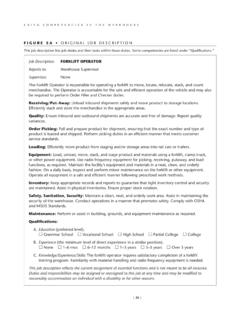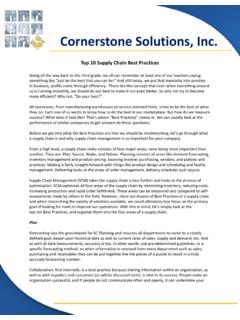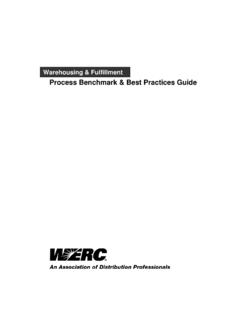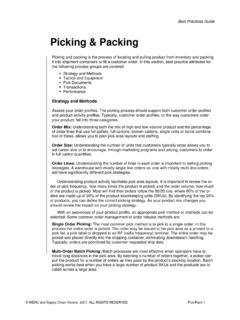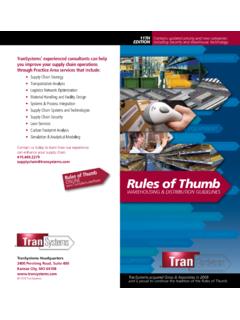Transcription of Warehouse Workflow Handbook - WERC
1 Warehouse Workflow Handbook The inherently variable nature of Warehouse and distribution operations is both a curse and a blessing. On the one hand, it is unpredictable, making planning a daily challenge. On the other, it is, as a friend of mine likes to say fraught with opportunities. It is dynamic and, therefore, especially amenable to the concept of continuous improvement. For many of the same reasons, these operations sustain the image of being good places to cut costs and to improve performance. Things customers, products, markets, vendors, and systems are constantly changing. Because they are interdependent, the mix is never dull. Improvements are always possible and often significant. Looking at strategies for optimizing work flow in the distribution center should be an ongoing process and it continues to pay dividends over time.
2 General Principles The first thing most distribution executives will tell you when you begin to examine how and why things are as they are is We are unique. Despite that widely held belief, there are some fundamental principles that apply widely if not universally. Five of our favorites are: Reduce product handling everywhere (labor, damage). Eliminate travel wherever possible (labor, time). Minimize the number of steps in any process (simplification, ease of completion) Eliminate handwritten data of all kinds (errors, delay, communication, dissemination) Do not let people do anything a computer can do better (common sense, serious competitive advantages). While none of these will apply to the same degree to every operation, each of them will point to opportunities to improve product flow and work activities in every facility we have seen in the past 15 years.
3 Their feasibility is a function of customer requirements, resources (sometimes including capital) and management s will to make the necessary changes. Below is a list of somewhat more specific items gleaned from recent audits we conducted at three new clients. While this list is intended to be neither comprehensive nor prioritized, it contains representative material that either bears directly on Workflow , or will take advantage of Workflow conditions to further improve customer service and the cost of operations. It is a simple way to convey some of the breadth of this topic. Operating Procedures Stagger work schedules based on work flow; reduce labor and minimize congestion by varying when people start, when they take lunches and breaks, and how long they work Perform all work in a single shift, if possible.
4 This can help accelerate product flow to the areas of need and enhances communication across functions Assign work to individuals, not teams. Individuals will get more done than teams in most Warehouse work activities; if you need teams, make them small ones Preprint labels and documents; avoid any machinery dictating work flow or pace if possible Provide formal training and cross training for all employees. This will help assure that the preferred methods and procedures are being followed and that best practices are understood and practiced. Receiving Schedule all inbound receiving, based on the nature and size of the load. Dock space utilization will improve using this technique and the intake process will be more efficient Copyright, Tom Zosel Associates 1 Assign loads to doors adjacent to product destinations.
5 This will reduce travel while increasing the availability of material handling equipment Have vendors pre-label and unitize inbound product. Handling can be significantly reduced and holding capacity utilization improved by applying this concept Certify vendors and work inbound shipments according to quality. Certifying vendors can greatly streamline the receiving and put-away activities, and inbound shipments which conform with your guidelines will impact almost every downstream Warehouse function as well Put-away Put-away everything the same day. There is no substitute for timely processing of inbound deliveries because it impacts space, congestion, purchasing, service levels, customer satisfaction and, oh yes, sales and profits Route put-away based on destination locations.
6 Travel can be reduced to a large degree when the travel path is sequenced based on the shortest route for the SKUs in each specific load Productivity Management Maintain and use standards in all major functional areas. This will assist management in identifying systemic bottlenecks such as aisle congestion or other Workflow problems Periodically review methods to be sure they are relevant, effective & documented. As products and packaging change, as vendors and customers change, so do your methods need to change to maintain optimal work flow and performance Measure individuals, not teams. To determine if a productivity problem is systemic or individual, and therefore to understand how to tackle it, a manager must know how individuals are performing Reward individuals and teams.
7 By combining some individual and some team, group or facility elements in the reward calculation, individuals are protected from some of the variation in work that they cannot control (systemic problems, work volumes in seasonal situations) and it helps take the edge off the negative aspects of competition Space Utilization Re-slot early and often; product should be placed in the optimal location to minimize handling, travel, and availability Use overhead space (the greatest opportunity in many facilities). Beyond increasing holding capacity, this practice can enable the location of dog inventory where it does not impede the movement of more productive items Eliminate aisles to add space. By varying storing techniques and fixtures based on various characteristics of the product (physical traits, velocity, etc.)
8 , some aisles can either be reduced or eliminated, creating space, besides impacting both handling and travel Selection Deliver work to pickers. Eliminate a central pick up point for documents; pickers should pick and minimize the travel to do so Include pallet building skills in picker training and slotting strategies. By attending to pallet building requirements in both areas, the process of selecting, packing and shipping goods to fill orders will be streamlined and handling will be reduced Copyright, Tom Zosel Associates 2 Quality Move from 100% checking to statistical checking. It can pretty readily be demonstrated that error rates to not decline as the extent of checking goes up; statistical checking reduces labor and delays, but facilitates the identification of systemic problems in the work flow that cause errors Fully utilize systems already in place.
9 It is surprisingly common to find operations in which software, best practices or standard procedures have been neglected, abandoned or left unchanged and underutilized over time, despite their potential value Many of the concepts touched on above require little or no capital, can be repeated over time with benefit, and are comparatively easy to understand and implement. We commend them to you. About TZA Tom Zosel Associates (TZA) is the world leader in optimizing logistics performance. Consistently delivering results for numerous logistics leaders, TZA helps clients reduce operating costs, substantially improve logistics processes, eliminate bottlenecks, increase throughput and capacity, achieve material handling automation goals, and optimize total logistics network performance.
10 These results are achieved through a focused portfolio of consulting services and technology tools. TZA s unique methodology, which helps companies improve strategic decisions through an unbiased, comprehensive evaluation of appropriate alternatives, enables companies to achieve their logistics goals at the minimum level of required investment. TZA s core competencies include Strategic Network Design, Facility Design and Material Handling Engineering, Transportation System Design, Logistics Software Solutions and Productivity Improvement Programs. TZA s ProTrack software offers the industry s most powerful labor planning and reporting software solution. TZA is passionate about helping its clients succeed with a laser-focused methodology built on value realization. 3880 RFD Salem Lake Drivei Long Grove, IL 60047i 847-540-6543i fax: 847-540-9988 Copyright, Tom Zosel Associates 3

